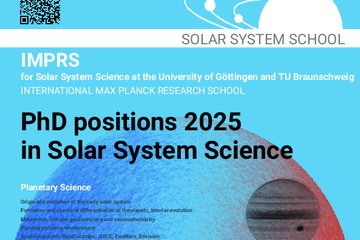All genres
61.
Journal Article
On the first ionization potential effect of the solar corona. Advances in Space Research 11, pp. (1)247 - (1)250 (1991)
62.
Journal Article
Giotto IMS measurements of the production rate of hydrogen cyanide in the coma of comet Halley. Annales Geophysicae 8 (5), pp. 319 - 326 (1990)
63.
Journal Article
Cometary ion flow variations at comet P/Halley as observed by the Giotto IMS experiment. Annales Geophysicae 8, pp. 229 - 238 (1990)
64.
Journal Article
Stability of the cometary ionopause. Advances in Space Research 9, pp. (3)305 - (3)308 (1989)
65.
Journal Article
Observations of a shock and a recombination layer at the contact surface of Comet Halley. Journal Geophysical Research 94, pp. 17251 - 17257 (1989)
66.
Journal Article
Evidence for methane and ammonia in the coma of comet P/Halley. Astronomy and Astrophysics 187, pp. 502 - 512 (1987)
67.
Journal Article
The composition and dynamics of cometary ions in the outer coma of Comet P/Halley. Astronomy and Astrophysics 187, pp. 163 - 168 (1987)
68.
Journal Article
Giotto-IMS observations of ion flow velocities and temperatures outside the contact surface of comet P/Halley. Astronomy and Astrophysics 187, pp. 174 - 178 (1987)
69.
Journal Article
The formation of a magnetic field free cavity at comet Halley. Nature 325, pp. 418 - 429 (1987)
70.
Journal Article
An Interpretation of the ion pile-up region outside the ionospheric contact surface. Astronomy and Astrophysics 187, pp. 132 - 136 (1987)
71.
Journal Article
Ion temperature and flow profiles in comet P/Halley's close environment. Astronomy and Astrophysics 187, pp. 160 - 162 (1987)
72.
Journal Article
The solar wind shock termination. Advances in Space Research 6, pp. 27 - 32 (1986)
73.
Journal Article
Ion composition and dynamics at Comet Halley. Nature 321, pp. 330 - 334 (1986)
74.
Journal Article
Metallic ions in cometary comae and plasma tails. Nature 321, pp. 682 - 684 (1986)
75.
Journal Article
The acceleration of particles in the vicinity of comets. Planetary and Space Science 34, pp. 1061 - 1065 (1986)
76.
Journal Article
Estimates of galactic cosmic ray spectra at low energies. Astronomy and Astrophysics 149, pp. 7 - 10 (1985)
77.
Journal Article
A weak interaction model for Io and the Jovian magnetosphere. Nature 283, pp. 180 - 183 (1980)
78.
Journal Article
The acceleration of minor ion species in the solar wind. Astrophys. and Space Phys. 64, pp. 183 - 211 (1979)
79.
Journal Article
Quiet-time interplanetary cosmic ray anisotropies observed from Pioneer 10 and 11. Journal Geophysical Research 83, pp. 1633 - 1640 (1978)
80.
Journal Article
Anomalous acceleration of minor ions in the solar wind. Nature 274, pp. 350 - 351 (1978)











